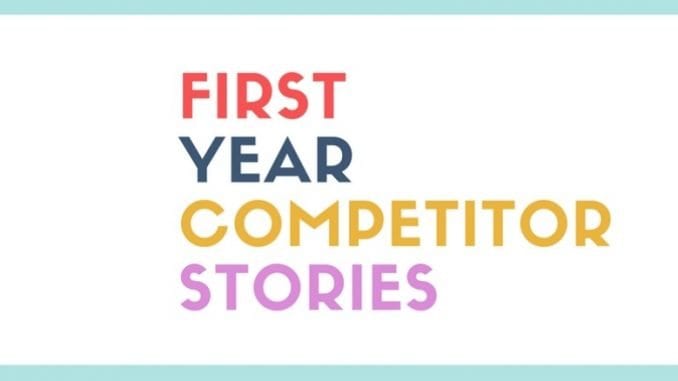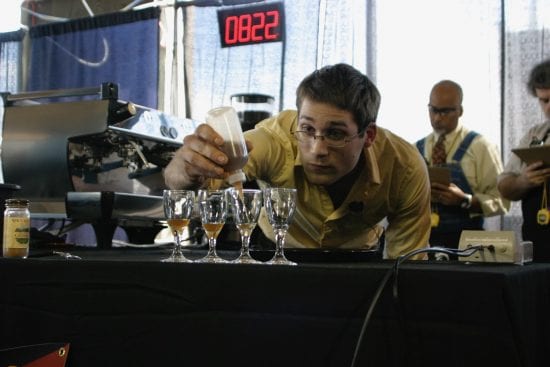
Spilled drinks, misunderstood rules, and countless hours of practice—this is what first year coffee competitors go through. We revisit their experiences for stories that will inspire, motivate, and perhaps make you cringe.
In this series, we share stories from competitors’ first year of competition at the United States Coffee Championships. Some stories are from newly minted competitors, and others feature the success and horror stories from veteran competitors in seasons past. (Read stories in this series from Kay Cheon, Amy Trompeter, Cameron Heath, T. Ben Fischer, Jenna Gotthelf and Tracy Gill.) If you’re interested in contributing a story about your first year of competition, drop us a line!
VOLUME 7: BY COLIN WHITCOMB
Coffee competitions these days are ultra competitive—not just during the actual competition, but getting even a spot to compete usually involves sitting at your computer refreshing the registration page until it goes live. So far in this series, we’ve been fortunate to share stories of very recent competitors, but Colin Whitcomb, longtime Barista Guild member and coffee veteran, shares his memories and experiences competing in 2008, when competitors were still serving blends, the espresso machine faced away from the judges, and the idea of a polished routine was still light years away. Read on as Colin shares his memories of his first barista competition 10 years ago.
I participated in my first barista competition, the Great Lakes Regional Barista Competition (GLRBC), in March of 2008. In 2008, the the barista competitions were broken up into something like 10-12 separate regionals. Usually each competition was three days, with a finals on Sunday where the top-six-scoring baristas would compete.
It was not the case that every region held a competition; frequently two regions would lump their competitions together because participation was low or nonexistent in some states. If I remember right, the only requirement for entry into the United States Barista Championship was participation in a regional. Previous USBC champs could skip regionals and enter straight into the USBC.
Because of the number of competitions, it was usually very easy to enter into a regional, and the baristas who showed up had skills and routines all over the map. Some companies, like Intelligentsia, were way ahead of the curve in how they played the game. A lot of routines I recall were off-the-cuff and occasionally kooky.

The format and rules for the USBC were different. The total number of available points on a scoresheet was balanced between technical and sensory. The espresso machine faced away from the judges: Baristas would compete inside a box, turning away to prepare the coffee. Competitors were required to provide sugar. Flecking was evaluated. Competitors could hide objects underneath a prep table at the end of the routine where they would not be counted under workstation cleanliness. There are myriad other rules that have been left behind as the industry evolved. Liz Clayton wrote an excellent record of competitions at that time.
At some point in 2008 I became aware that the roasting company I worked for, then known as Alterra Coffee, now known as Colectivo Coffee, was going to host the GLRBC. Our barista trainers, Scott Lucey and Justin Tiesl, had both competed in the 2007 USBC in Long Beach, Calif., and Scott had judged in 2006 at the Charlotte USBC. Scott or Justin told me they thought I should compete. I had competed in the Millrock Latte Art Competition at Coffee Fest in June of 2007, and had the bug for coffee.
I wrote to Scott in an email in Jan of ’08: “Okay I would like to try and compete in the GLRBC … I guess my reservations are mostly nerves, or laziness. Everyone seems to think I should do this, and that aside, this feels like the right time. If I don’t compete now, the next opportunity would be in a year, and things could be quite different then.” I followed that observation by adding: “I am considering a sig bev with lychee fruit. Please advise.”
2007/8 was a time when more baristas began to choose single-origin coffees for competition, but many used a blend, often the house espresso blend at their café or roastery. Billy Wilson had used Hair Bender [from Stumptown] not long before this. I decided that I would create my own espresso blend—I created a three-bean blend using coffee from Coopedota, a natural-processed coffee from a farm called Fazenda São Domingos, and coffee from a roastery called Don Zeledon from a co-op in Northern Nicaragua. (The blend was two parts of the Brazil, one part each of the Costa Rican and Nicaraguan coffees).
On the face of it, it would seemingly be a good espresso, and it probably was good one out of 10 times if my dosing wasn’t so all over the place when I got nervous. We used a Mazzer Robur with a dosing chamber, I didn’t weigh any doses, measured shots by volume, and was trying to learn how to distribute the coffee evenly in the basket by hand. I had been trained to make espresso by mounding coffee in the basket, chopping across it with a butter knife, and leveling excess into the dosing chamber or knockbox.
I was not instructed to work off a script, and I had a collection of ideas and sentences that I would string together and rephrase—every run was an improvisation, including my final competition run. This was the way I built barista routines until 2012. The best habits I was taught at this time were to practice the practice time (unloading the cart, dialing in, etc., prior to competition), and also never to stop the routine when I made a mistake.
A signature drink persistently evaded me. I had no taste for any beverage, except maybe coffee, and the task of creating a good signature drink was well beyond my reach. At Alterra’s in-house competition before the GLRBC, I made a drink based off a root beer float. Afterward, I changed my drink to a cinnamon-raisin macchiato. Had it been executed well, it might have been an enjoyable drink (even if it was a little on-the-nose). I chose to dollop foam on top of the espresso, and then dust it with cinnamon. The espresso was mixed with a raisin syrup. There were no drinking instructions.
The Intelligentsia team wore matching American Apparel jackets in blue, with white piping, and an orange logo with a skull. Charles Babinski and Talya Strader competed that year. Matt Riddle had won the USBC a few years before, and the Intelligentsia team carried a cardboard cutout of Matt around.
On my first competition soundtrack I played “Coffee Time” by Carmen McRae, “The Magic Number” by De La Soul, “The Blues Are Still Blue” by Belle and Sebastian, and “Fanatic of the B-Word,” by De La Soul, in that order. The soundtrack played past 17:00 minutes just in case I went over time.
When the time came to compete, I was very nervous; however, I drank most of a bottle of sparkling wine that morning and was generally in a nothing-to-lose kind of mood. I had a display of wilty tulips and had chosen La Croix in bottles for my judges. I wore a pale-yellow button-up and a pair of straight-leg heavyweight gray chinos from J.Crew. Ten years later, most of that moment is a blur. I made a mistake with my sig bev glasses—they didn’t fit under the portafilter spouts. I didn’t serve my judges water. My dosing lacked consistency, and my technical and sensory scores suffered. I rushed through and finished at 13:36, about 90 seconds faster than any routine I had ever done.
I have almost no recollection of what was said at the competitor debrief. There were several, “But we really enjoyed you.” I was disappointed that I didn’t do better, and as a consequence I wouldn’t be able to compete at the USBC in Minneapolis. I’m surprised by how little I understood how to earn points in the competition. It didn’t matter. On Sunday I was elated: Many of my friends were in attendance, I had another quantity of sparkling wine, and began to feel as if I was in on something. I had no plans to make a career out of coffee, to use competition as a tool to further myself in the industry—although I soon would—I was falling in love with the community.
I look back on this as an idyllic and almost carefree time of my life, as you can probably tell. (Although I shouldn’t: I defaulted on my student loans that spring and soon after developed an infected tooth for which I had no dental insurance.) That competition is one of a number of things that kept me in coffee, and I used to underestimate how lucky I was to have all the support approaching it; reading stories like the one by Jenna Gotthelf, I am humbled.

